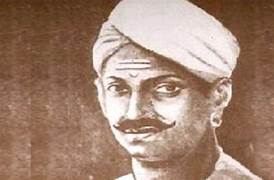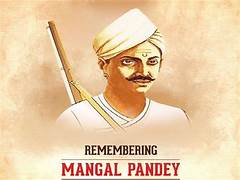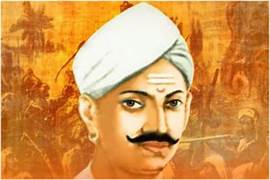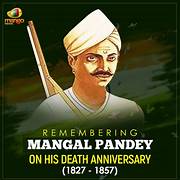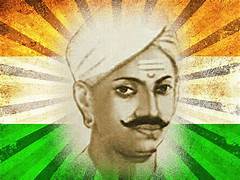Mangal Pandey, a crucial character in India’s war for independence, was instrumental in sparking the insurrection against British colonial rule. Born in 1827 in Uttar Pradesh, Pandey joined the British East India Company’s army and served as a sepoy (soldier). It was during his time in the army that he witnessed firsthand the injustices and discrimination faced by Indian soldiers.
Rumors that the new Enfield weapons’ cartridges were covered with pig fat, which offended the religious sensibilities of both Muslim and Hindu soldiers, caused tensions to spike in 1857. Pandey refused to use the cartridges and incited his fellow soldiers to join him in rebellion. On March 29, 1857, he attacked his British superiors at Barrackpore, triggering what would become known as the Sepoy Mutiny or the First War of Indian Independence.
Even though the British caught and killed Pandey, his courage and defiance encouraged countless more to take up the battle for freedom. Mangal Pandey’s actions marked the beginning of a larger movement that ultimately led to India’s independence from British rule. His legacy is still celebrated today as a symbol of bravery and resistance to injustice.
Mangal Pandey Early Life:
Born in Nagwa, a tiny town in modern-day Uttar Pradesh, India, on July 19, 1827, Mangal Pandey became a well-known character in Indian history. He grew up in a culture greatly affected by traditional beliefs and traditions because he comes from a Brahmin family. His early schooling is unknown, but at a young age, he enlisted in the Bengal Native Infantry, the army of the British East India Company.
The severe rules and discriminating actions that the British inflicted upon Pandey during his tenure in the army only helped to increase his already growing resentment. The introduction of the new Enfield weapon, lubricated with animal fat, infuriated Indian soldiers since it went against their traditional and religious values. This problem, along with a general feeling of unhappiness among the Indian soldiers, or sepoys, created the conditions for what transpired in 1857.
Mangal Pandey’s upbringing and army service were significant influences on his worldview and beliefs. The events in Barrackpore on March 29, 1857. This fired the bigger rebellion known as the Indian Rebellion of 1857 and represented his eventual defiance of the British. Mangal Pandey’s bravery and persistence will make him a legendary figure in Indian history, representing the people’s resistance against colonial oppression.
Mangal Pandey Education:
On July 19, 1827, Mangal Pandey, a well-known character in Indian history, was born in the Uttar Pradeshi village of Nagwa in the Ballia region. Most people agree that Mangal Pandey received some basic schooling when he was younger. Despite the fact that there is little information about his official schooling. In nineteenth-century rural India, formal education was rarely available to those from lower socioeconomic status, and instruction was frequently of a primitive nature.
When Mangal Pandey enlisted in the British East India Company’s army, his life took a dramatic turn. His life took a turbulent turn when he enlisted in the 34th Bengal Native Infantry. Which ultimately led to his involvement in the significant events surrounding the Indian Rebellion of 1857. Despite having a limited education, Mangal Pandey’s actions and convictions during a pivotal moment of struggle against British colonial power had a significant impact on the trajectory of Indian history.
The history of India’s freedom movement bears Mangal Pandey’s name, particularly in light of his role in the 1857 Barrackpore Mutiny. His refusal to use brand-new cartridges purportedly greased with pig fat, which offended religious sensibilities, became a symbol of defiance. In the end, this incident aided in the larger rebellion against British control.
Mangal Pandey’s legacy stems from his courage, commitment, and pivotal role in India’s early independence struggle. Despite the paucity of information regarding his formal schooling. His resistance to oppressive colonial policies and selfless sacrifice continue to inspire generations of Indians.
Introduction of the New Rifle Cartridge:
Mangal Pandey was a key figure in the Indian Rebellion of 1857, also known as the Sepoy Mutiny. One of the catalysts for the uprising was the introduction of a new rifle cartridge that played a significant role in the events leading up to the rebellion.
The British East India Company introduced a new Enfield rifle to the Indian soldiers (sepoys) in its army. The bullets used for these rifles were lubricated with a combination of beef and pork fat. To load the rifle, soldiers had to bite off the top of the cartridge, and this act was deeply offensive to both Hindu and Muslim soldiers. Hindus felt that feeding meat was against their beliefs, whilst Muslims believed that pork was forbidden by Islam.
Mangal Pandey, a sepoy in the British East India Company’s army, took a stand against this perceived religious insult. On March 29, 1857, in Barrackpore, Bengal, Mangal Pandey attacked his British officers, making an attempt to incite a larger rebellion among the sepoys.
Mangal Pandey’s act of rebellion against the usage of modern rifle cartridges is often seen as the start of the Indian Rebellion of 1857. His actions symbolized the broader discontent among the Indian soldiers and the population at large against British rule and their insensitivity to Indian religious and cultural sentiments. The aftermath of his uprising was a watershed in Indian history and profoundly affected how the country’s independence movement unfolded.
Mangal Pandey Trial:
Mangal Pandey, an Indian soldier in the British East India Company’s army, played a pivotal role in sparking the Indian Rebellion of 1857, also known as the Sepoy Mutiny. The trial of Mangal Pandey is a significant episode in the lead-up to the uprising. On April 8, 1857, at the Barrackpore cantonment, Pandey attacked British officers, including Lieutenant Baugh, with his musket, leading to his subsequent arrest and trial.
During the trial, Mangal Pandey vehemently defended his actions, citing various grievances that had fueled widespread discontent among Indian sepoys. Rumors circulated that new rifle cartridges were covered with animal fat, which was the exact cause of his rebellion. Practice offensive to both Hindu and Muslim soldiers. Pandey argued that the cartridges violated religious principles, and he refused to use them.
The trial highlighted the underlying tensions and dissatisfaction among Indian soldiers within the British-controlled army. Mangal Pandey’s resistance symbolized the broader sentiments of defiance against British rule and exploitation. His bravery and sacrifice prompted thousands to join the movement, which sparked a widespread revolt against British domination in India.
Ultimately, Mangal Pandey was sentenced to death by hanging. His execution further fueled the flames of discontent, contributing to the eruption of the Indian Rebellion of 1857. The Indian independence movement benefited by the rebellion, even though the British eventually put an end to it. Which gained momentum in the following decades. As a reminder of resistance and the early fight for India’s freedom from colonial authority, Mangal Pandey’s legacy lives on.
Mangal Pandey Execution:
Mangal Pandey, a pivotal figure in Indian history, played a significant role in the events leading up to the Indian Rebellion of 1857 against British colonial rule. Born in 1827 in North India, Mangal Pandey was a sepoy (soldier) in the British East India Company’s army. His execution is a poignant moment in the narrative of resistance against British oppression.
The catalyst for Pandey’s actions was the introduction of the Enfield rifle. They forced soldiers to nibble off the ends of cartridges supposedly coated with cow and pig fat. This act was offensive to both Hindu and Muslim soldiers, as it violated their religious beliefs. In protest, Mangal Pandey led a rebellion at Barrackpore on March 29, 1857, attacking British officers.
His defiance marked the beginning of a larger uprising that eventually spread across India. Mangal Pandey made minimal effort and was apprehended. On April 8, 1857, he was court-martialed and sentenced to death by hanging.
The execution of Mangal Pandey became a symbol of resistance against colonial oppression, and his legacy inspired others to join the fight for independence. It is viewed as the spark that ignited a much larger fire, resulting in the 1857 insurgency against British rule. Which remains a pivotal chapter in India’s struggle for independence.
Mangal Pandey Military Service:
Born in Nagwa, Uttar Pradesh, India, on July 19, 1827, Mangal Pandey served in the British East India Company’s army. His most famous contribution to history is his part in the prelude to the Indian Rebellion of 1857, popularly referred to as the Sepoy Mutiny.
Mangal Pandey’s military service began when he joined the 34th Bengal Native Infantry in 1849. He was part of the Bengal Army, which was a crucial component of the British East India Company’s military forces. The East India Company maintained a large army composed mostly of Indian soldiers, known as sepoys, who served alongside British officers.
During his service, Mangal Pandey witnessed various issues and grievances among the Indian soldiers. Anger with the use of brand-new cartridges that were supposedly lubricated with a blend of pig and cow fat. Given that Muslims view pigs as filthy and Hindus view cows as sacrosanct, this infuriated both Muslim and Hindu soldiers.
Considered to be the catalyst for the greater uprising against British rule was Mangal Pandey’s March 29, 1857, protest against the usage of these cartridges in Barrackpore. His act of defiance against the British officers led to his arrest and subsequent trial. His actions had a lasting effect on Indian soldiers and citizens, even after his execution on April 8, 1857. Contributing to the widespread uprising against British rule in India.
Mangal Pandey’s military service, while relatively short-lived, played a significant role in the historical narrative of India’s struggle for independence, making him a symbol of resistance and patriotism. India honors him for his contributions as a pivotal player in the early phases of the struggle against colonial control.
Mangal Pandey’s Revolt:
Mangal Pandey, a sepoy in the British East India Company’s army. Played a pivotal role in sparking the Indian Rebellion of 1857, also known as the Sepoy Mutiny or the First War of Independence. Born in 1827 in the northern part of India, Mangal Pandey became a symbol of resistance against British rule.
Several things contributed to the dissatisfaction of Indian troops in the army of the British East India Company. And the introduction of the new Enfield rifle bullets, rumored to be lubricated with pig and calf fat. Loading the cartridges required biting off the ends, which deeply offended the religious sentiments of both Hindu and Muslim sepoys.
Mangal Pandey, stationed in Barrackpore, near Calcutta (now Kolkata), refused to use the new cartridges on March 29, 1857. His resistance and subsequent attack on his British superiors set off a chain of events that resulted in widespread insurrection. Many people believe that this tragedy marked the beginning of the greater rebellion against British control.
The rebellion, which spread across northern and central India, saw the participation of sepoys and civilians alike. After being detained and executed on April 8, 1857, Mangal Pandey’s courage and valor inspired others to fight for independence. The events that unfolded in the aftermath of Mangal Pandey’s revolt marked a turning point in Indian history. Leading to increased tensions and eventually the formal end of the East India Company’s rule over India in 1858.
Mangal Pandey Arrest:
Mangal Pandey, an influential figure in the Indian independence movement, played a pivotal role in the events leading up to the Indian Rebellion of 1857. Born in 1827 in Nagwa, a village in present-day Uttar Pradesh, Pandey was a sepoy (soldier) in the British East India Company’s army.
The arrest of Mangal Pandey took place on March 29, 1857, at Barrackpore, near Calcutta (now Kolkata). The incident marked a critical turning point that eventually led to the widespread uprising against British rule in India. Soldiers had to bite off the paper seal on the new Enfield rifle cartridges since it was rumored that they were coated with pig and cow fat. This was what set off Pandey’s act of defiance. This offended both Hindu and Muslim sepoys, as it violated their religious beliefs.
Mangal Pandey publicly defied his British commanders, refusing to use the cartridges and rallying fellow sepoys in protest. For defying orders, Pandey was captured and found guilty in a court martial. His trial and subsequent execution on April 8, 1857, fueled widespread discontent among the Indian soldiers and civilians, leading to the eruption of the Indian Rebellion of 1857.
Even though it appeared to be a small-scale event, Mangal Pandey’s imprisonment sparked a wider rebellion against British colonial power. It marked the beginning of a significant chapter in India’s struggle for independence. As the events unfolded into a widespread and coordinated revolt against British authority across various parts of the country.
Sepoy in the British East India Company:
The British East India Company’s sepoy (soldier) Mangal Pandey played a crucial role in the Indian independence movement. Born in 1827 in northern India, Mangal Pandey served as a soldier in the 34th Bengal Native Infantry regiment. In 1857, he played a significant role in the events that led to the Indian Rebellion of 1857. Also known as the Sepoy Mutiny or the First War of Independence.
Mangal Pandey’s name is particularly associated with the incident on March 29, 1857, at Barrackpore in British India. Where he rebelled against his British superiors. As the first batch of Enfield cartridges were launched, he became outraged because they were reported to be lubricated with pig and cow fat. Which offended the religious sensibilities of both Hindu and Muslim soldiers. This incident escalated tensions and eventually contributed to the widespread rebellion against British rule.
Mangal Pandey’s courage and rebellion became a symbol of resistance, inspiring many others to join the uprising against British rule. On April 8, 1857, he was executed after being found guilty of his crimes, which had led to his capture. Mangal Pandey’s sacrifice and the events surrounding his revolt had a lasting impact on the Indian independence movement. He is regarded as a hero because of his fight against oppression and injustice. Many people believe that his involvement in the insurrection served as a model for the greater Indian independence movement that grew in strength during the ensuing decades.
Mangal Pandey Symbolism:
Mangal Pandey, a historical figure in Indian history, holds great symbolism for various aspects, embodying the spirit of resistance, courage, and the fight against injustice. His name is commonly associated with the Sepoy Mutiny of 1857. Also known as the Indian Rebellion of 1857, which played a pivotal role in India’s struggle for independence.
Mangal Pandey’s actions symbolize the spark that ignites the flames of revolt. His refusal to use the newly introduced cartridges greased with animal fat, perceived as an affront to religious sentiments. Became the catalyst for a larger movement against British colonial rule. In this context, Pandey becomes a symbol of religious and cultural resistance, reflecting the broader sentiment of Indians who felt marginalized and oppressed.
Furthermore, Mangal Pandey represents the idea of individual sacrifice for the collective good. His act of rebellion, which ultimately led to his execution, showcases the willingness to stand up against tyranny, even at personal cost. This sacrifice resonated with the masses and contributed to the unification of diverse communities in their common struggle against colonial oppression.
Mangal Pandey’s legacy also symbolizes the power of historical memory. The retelling of his story through various mediums, including literature, film, and folklore, serves as a constant reminder of the indomitable spirit of resistance against injustice. Mangal Pandey’s symbolism has helped shape the story of India’s fight for freedom, motivating future generations.
In essence, Mangal Pandey’s symbolism encompasses resistance, sacrifice, and the collective spirit of a people striving for freedom and justice. His legacy remains an enduring symbol in the tapestry of India’s struggle against colonial rule, serving as a source of inspiration for those who seek justice and equality.
Impact on the Indian Rebellion of 1857:
Mangal Pandey, a sepoy of the British East India Company’s army, was instrumental in starting the Indian Rebellion of 1857. On March 29, 1857, he refused to use the newly imported Enfield rifle cartridges lubricated with animal fat. Triggered widespread resentment among the sepoys. Many people believe that this section served as the catalyst for the greater uprising against British rule.
Mangal Pandey’s courageous stand against the British not only symbolized the growing discontent among the Indian soldiers but also resonated with the broader population that harbored grievances against the East India Company’s policies. His actions served as a rallying point, inspiring others to join the rebellion and challenge the oppressive British rule.
The impact of Mangal Pandey’s defiance extended beyond his individual act of rebellion. It fueled a sense of nationalism and unity among diverse Indian communities, fostering a collective resistance against colonial rule. The events that followed his act, including the widespread mutinies across various regiments and regions, culminated in the Indian Rebellion of 1857. Although the rebellion faced eventual suppression. Mangal Pandey’s courage and sacrifice laid the groundwork for the later independence movement in India.
In the post-rebellion period, Mangal Pandey became a symbol of resistance and a folk hero in India. His legacy continued to inspire subsequent generations in their struggle for freedom. Contributing to the narrative of India’s quest for independence from British colonial rule. Mangal Pandey’s impact on the Indian Rebellion of 1857 transcended the immediate context. Leaving an indelible mark on the history of India’s fight for self-determination.
Symbol of Resistance:
Mangal Pandey, an Indian soldier in the British East India Company, emerged as a powerful symbol of resistance during the Indian Rebellion of 1857. His act of defiance against the usage of new Enfield rifle cartridges allegedly lubricated with cow and pig fat. Sparked widespread discontent among Indian soldiers. For Pandey, this was not just a protest against the controversial cartridges but a stand against the overall oppression and disrespect faced by the Indian sepoys.
Mangal Pandey’s boldness and defiance inspired his fellow soldiers and ignited the flames of resistance against the British rule. He became a rallying point for those who sought to challenge the colonial regime and reclaim their dignity and freedom. His actions marked the beginning of a larger movement that eventually escalated into the First War of Indian Independence.
Mangal Pandey’s importance comes from both his immediate influence and the enduring legacy he left behind. He symbolizes the spirit of resistance against injustice, tyranny, and foreign rule. Even though the British eventually destroyed his insurrection, Mangal Pandey’s memory continues to inspire generations of freedom fighters. Who followed, contributing to the eventual independence of India in 1947.
In retrospect, Mangal Pandey’s courageous stance and sacrifice have solidified his place in Indian history as a symbol of resistance. A reminder of the indomitable spirit that can arise in the face of oppression, and a catalyst for the larger struggle for independence. His story serves as a testament to the resilience and determination of individuals who dare to challenge the status quo in pursuit of justice and freedom.
Mangal Pandey Commemoration:
Mangal Pandey holds a significant place in Indian history as a key figure in the struggle against British colonial rule. Born in 1827, Mangal Pandey served as a sepoy (soldier) in the British East India Company’s army. The year 1857 was a watershed moment in his life and in Indian history, when the Indian Rebellion broke out. Also known as the Sepoy Mutiny or the First War of Indian Independence.
Mangal Pandey’s name became synonymous with the spark that ignited the rebellion. In Barrackpore on March 29, 1857, he declined to fire the recently supplied cartridges. It supposedly had fat from cows and pigs to lubricate them. Which deeply offended the religious sentiments of Hindu and Muslim soldiers. His act of disobedience not only signified opposition to British oppression, but also sparked a greater revolt.
Mangal Pandey’s courage and commitment to his principles inspired many others to join the rebellion. Marking the beginning of a widespread movement against British rule. Despite the eventual suppression of the uprising by the British, Mangal Pandey’s sacrifice became a symbol of resistance and resilience for generations to come.
Mangal Pandey’s contribution to India’s struggle for independence is honored on this day. Numerous memorials, statues, and events honor his contribution, acknowledging the pivotal role he played in the early stages of the struggle against colonial domination. His legacy serves as a reminder of the sacrifices made by those who contributed to India’s eventual freedom in 1947. Mangal Pandey’s name is etched in history as a courageous individual. Who played a crucial role in the journey towards self-determination and freedom from foreign rule.
Legacy:
Known for his heroic deeds and unwavering commitment to justice throughout the turbulent period of British colonial administration in India, Mangal Pandey is a famous figure in Indian history. Born in the early 19th century, Mangal Pandey served as a sepoy in the British East India Company’s army. The incidents preceding the Sepoy Mutiny of 1857 are inextricably related to his legacy. Also known as the First War of Indian Independence.
Pandey’s defiance against the British East India Company’s oppressive policies came to the forefront in March 1857. When he sparked a mutiny in Barrackpore, near Calcutta (present-day Kolkata). Others insisted on not using the newly available Enfield pistol cartridges, stating that they were lubricated with pig fat. Which offended the religious sensibilities of both Hindu and Muslim soldiers. Became the catalyst for widespread rebellion among Indian soldiers in the Company’s army.
Pandey’s act of rebellion and subsequent execution by the British authorities galvanized Indians across the country, igniting a spirit of resistance against colonial oppression. He became a symbol of Indian nationalism and resistance against foreign rule, inspiring countless revolutionaries and freedom fighters in the decades to come.
Mangal Pandey’s memory survives as a symbol of bravery and patriotism, even after his capture and execution. His pioneering role in the struggle for Indian liberty will ensure that he is never forgotten. Whose sacrifice laid the groundwork for the eventual overthrow of British colonial rule. His name continues to evoke a sense of pride and admiration among Indians. Serving as a reminder of the sacrifices made by countless individuals in the fight for freedom and justice. Mangal Pandey’s indomitable spirit and unwavering commitment to his principles serve as an inspiration for generations to come, reaffirming the timeless values of bravery, integrity, and the quest for a just society.
Fact:
Mangal Pandey was a key figure in the Indian Rebellion of 1857, often referred to as the Sepoy Mutiny or the First War of Indian Independence. He was born on July 19, 1827, in Nagwa, a village in present-day Uttar Pradesh, India. Mangal Pandey served as a sepoy (soldier) in the British East India Company’s army.
One of Mangal Pandey’s crucial actions occurred on March 29, 1857, in Barrackpore, Bengal. Spurred by tales of animal fat in cartridges and rising resentment among Indian soldiers toward British control. Mangal Pandey led a rebellion against his British officers. Accused of lubricating the new Enfield rifle cartridges with pig and cow fat, he declined to use them. This act of defiance marked the beginning of a larger uprising.
Mangal Pandey’s insurrection had far-reaching ramifications, inspiring more soldiers to join the battle against British rule. It’s common knowledge that the events at Barrackpore served as the impetus for the broader uprising that erupted in subsequent months across northern and central India.
Unfortunately, Mangal Pandey was captured and executed on April 8, 1857. Despite the suppression of the immediate rebellion, his courage and sacrifice left a lasting impact on the Indian independence movement. Mangal Pandey, one of the founding heroes of the Indian liberation movement, is remembered as a symbol of anti-colonial resistance.
Death:
Mangal Pandey, an Indian soldier in the British East India Company’s army, played a significant role in the events leading up to the Indian Rebellion of 1857. On March 29, 1857, Pandey rebelled against his British officers at Barrackpore, near Calcutta. Following their denial of using recently designed Enfield rifle cartridges allegedly lubricated with pig and cow fat. Which offended the religious sentiments of both Hindu and Muslim soldiers. His act of defiance marked the beginning of a widespread uprising against British rule.
Pandey’s rebellion ultimately led to his arrest and subsequent trial by a military court. On April 8, 1857, Mangal Pandey was hanged at the parade field at Barrackpore. His death acted as a rallying point for sepoys and citizens disillusioned with British rule, and his legacy endured as a symbol of resistance to injustice. The events surrounding Mangal Pandey’s life and death contributed to the larger movement for Indian independence. Making him a revered figure in the history of India’s struggle against colonial rule.

